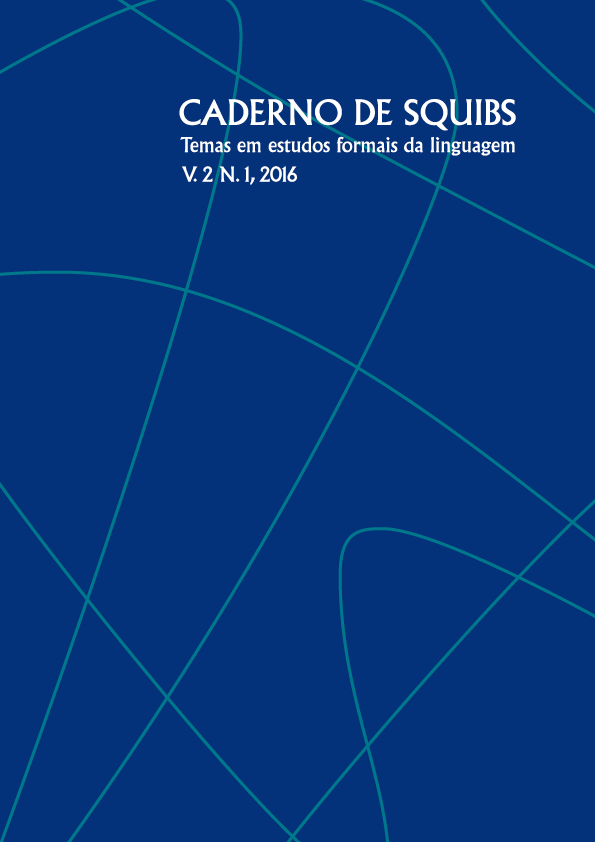Hierarchical relations and linear ordering
Keywords:
: Language universals, Linear ordering, Syntactic hierarchy, LCAAbstract
The present squib’s discussion is centered on Kayne’s (1994, 2010) proposals, which postulate a direct relation between the order of asymmetric c-command relations and linear precedence relations at PF. To put it briefly, Kayne argues that asymmetric c-command is mapped to linear precedence at PF and concludes that there is a universal hierarchical/linear order: Specifier Head-Complement. This universal order would predict the canonical order SVO found in many languages. Any other linear order, whether canonical or not, would then be obtained through movement operations. Details of the arguments in Kayne (1994, 2010) are presented and discussed in the present squib with focus on two goals: first, to show that the strict mapping of asymmetric c-command to linear precedence is questionable and, second, that linear precedence relations are not relevant for syntax, with only hierarchy playing a fundamental role ”” as also argued elsewhere (see CHOMSKY, 1995, 2004, 2005, 2008; URIAGEREKA, 1999; GUIMARA˜ ES, 2000). In doing this, circularity problems in Kayne’s arguments are highlighted as well as other issues. Subsequently, an alternative account of the relationship between syntax and PF is suggested, in an effort to maintain the spirit of Kayne’s LCA while at the same time making it compatible with more recent minimalist views.Downloads
References
CHOMSKY, N. Knowledge of Language: Its Nature, Origin and Use. Praeger, New York, 1986.
CHOMSKY, N. Bare phrase structure. In: WEBELHUTH, G. (Ed.). Government and Binding Theory and the Minimalist Program. Oxford: Blackwell, 1995. p. 383-439.
CHOMSKY, N. Minimalist Inquires: The Framework. MIT Occasional Papers in Linguistics. n. 15. Cambridge: The MIT Press, 1998.
CHOMSKY, N. Beyond explanatory adequacy. In: BELLETTI, A. (Ed.). The Cartography of Syntactic Structures. Oxford: Oxford University Press, 2004. p. 104-131.
CHOMSKY, N. Three factors in language design. Linguistic Inquiry, v. 36, n. 1, p.1- 22, 2005.
CHOMSKY, N. On phases. In: FREIDIN, R., OTERO, C., & ZUBIZARRETA, M., (Eds.). Foundational Issues in Linguistic Theory. Essays in Honor of Jean-Roger Vergnaud. Cambridge: The MIT Press, 2008. p. 291-321.
COLLINS, C. Eliminating labels. In: EPSTEIN, S. D. & SEELY, T. D. (Eds.). Derivation and explanation in the Minimalist Program. Maden, MA: Blackwell, 2002. 2, p. 42-64.
DRYER, M. S. Order of subject, object and verb. In: HASPELMATH, M., DRYER, M. S., GIL, D., & COMRIE, B. (Eds.). The World Atlas of Language Structures Online. Munich: Max Planck Digital Library, 2008.
DRYER, M. S. Order of Demonstrative and Noun. In: DRYER, M. S. & HASPELMATH, M. (Eds.). The World Atlas of Language Structures Online. Leipzig: Max Planck Institute for Evolutionary Anthropology, 2013. (Available online at http://wals.info/chapter/88, Accessed on 2016-04-22)
EPSTEIN, S. D., GROAT, E., KAWASHIMA, R. & KITAHARA, H. A Derivational Approach to Syntactic Relations. New York/Oxford: Oxford University Press, 1998.
ERDOCIA, K., LAKA, I., MESTRES-MISSEE, A. & RODRIGUEZ-FORNELLS, A. Syntactic complexity and ambiguity resolution in a free word order language: Behavioral and electrophysiological evidences from basque. Brain and Language, v. 109, n. 1, p. 1-17, 2009.
FARIA, P. O Axioma da Correspondência Linear e a Estrutura Sintagmática Nua: um levantamento de propostas de compatibilização. ˜ Filologia e Lingu´Ä±stica Portuguesa, 16 (spe), p. 261-285, 2014.
GUIMARÃES, M. In defense of vacuous projections in bare phrase structure. In: GUIMARÃES, M., ˜MERONI, L., RODRIGUES, C., & MARTIN, I. S. (Eds.). University of Maryland Working Papers in Linguistics, v. 9, p. 90-115. College Park, MD: UMWPiL, 2000.
KAYNE, R. S. The Antisymmetry of Syntax. Cambridge: The MIT Press, 1994.
KAYNE, R. S. Why are there no directionality parameters? New York University, 2010.
HORNSTEIN, N. A theory of syntax: Minimal operations and universal grammar. Cambridge, UK: Cambridge University Press, 2009.
SEKERINA, I. A. Scrambling and processing: Dependencies, complexity, and constraints. In: KARIMI, S. (Ed.). Word order and scrambling United Kingdom: Blackwell, 2003. p. 301-324.
URIAGEREKA, J. Multiple spell-out. In: EPSTEIN, S. D. & HORNSTEIN, N. (Eds.). Working Minimalism. Cambridge: The MIT Press, 1999. p. 251-282.
Downloads
Published
Issue
Section
License
Autorizo a publicação de squib/artigo de minha autoria e inteira responsabilidade para publicação.
I authorize the publication of the squib/paper of my authorship and full responsibility for publication.


